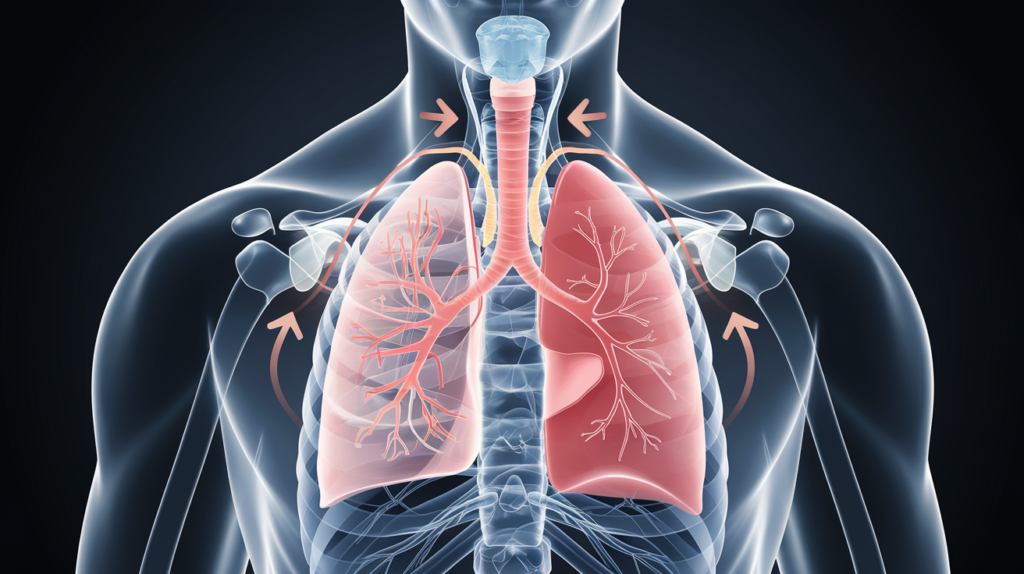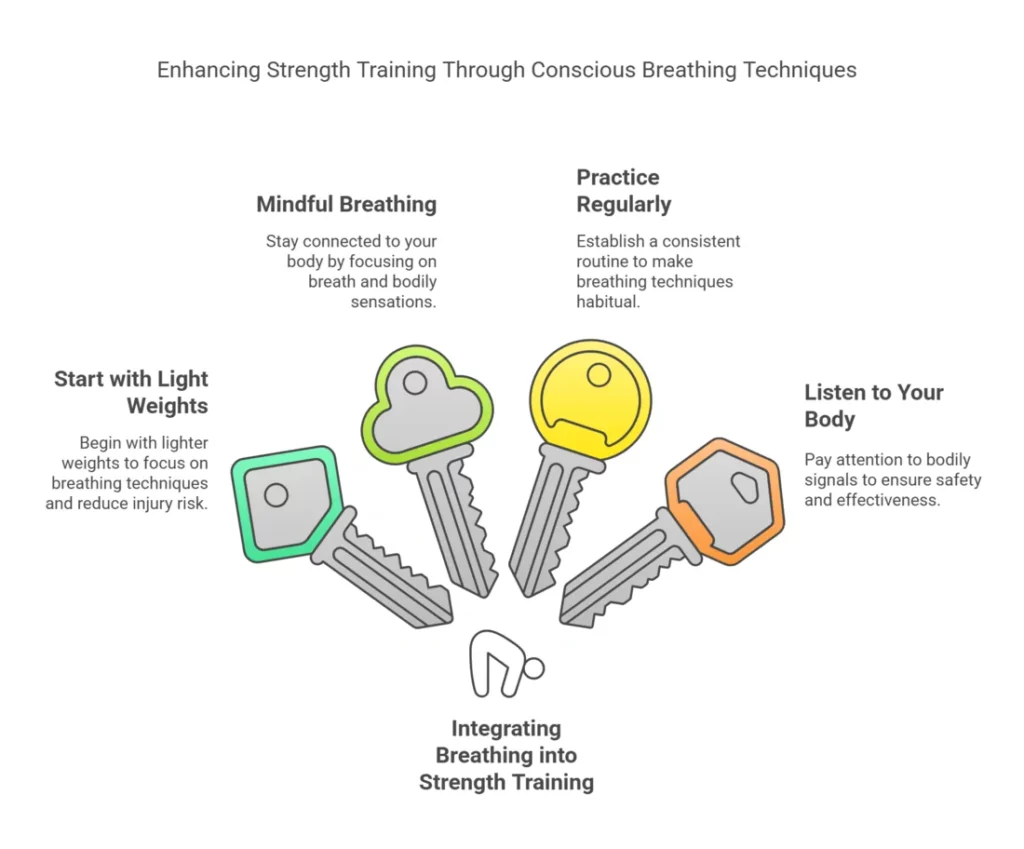Want to unlock your full potential in the weight room?
It is time to stop thinking that all you need to do is focus on your muscles.
The secret to truly maximizing your lifts may be a lot closer than you think – it could be all about your breath!
The truth is, breathing for strength training can revolutionize your workout experience, reduce your chances of injury, and boost your lifts to new heights.

This guide delves deep into the connection between breathing and strength training, and it also helps to explain how mastering your breath can help you enhance your lifts, by covering all the relevant techniques, and also the all-important science.
Get ready to learn why the way you breathe is so important, and how it can give you the advantage you need to reach your strength training goals!
The Science Behind Breathing During Strength Training
To fully grasp the impact of breathing on your strength training performance, it’s essential to understand the underlying physiological processes.
This section will explain how the method of breathing directly affects key functions such as oxygen, core stability and nervous system regulation.

Key Points
- The Role of Oxygen:
- Oxygen is the fuel that powers your muscles. Breathing effectively during strength training enables optimal oxygen delivery to your muscle cells, which helps to create ATP (adenosine triphosphate). This energy source will enable you to perform exercises for longer, and will also help to maximize your workouts overall. Without adequate oxygen, your muscles will fatigue quickly, and you will not be able to perform to the best of your ability.
- How Breathing Affects Core Stability:
- Proper breathing has a key connection with your core stability. Activating your core muscles is what allows you to perform safely, to lift heavier and to protect you from potential injury. Your breath is what allows you to create tension in your core, which will help you to stabilise your spine, and transfer force effectively during squats and deadlifts.
- The way you breathe can also have a direct influence on your posture, which also has a knock-on effect on your stability during workouts. It all comes down to using the correct method when breathing.
- The Connection to the Nervous System:
- The nervous system plays a role in coordinating muscle contractions and generating force, and your breath is directly linked to the nervous system. By using mindful breathing techniques, you can enhance the communication between your mind and your muscles, which will help to improve your technique, and also to enhance your mind-muscle connection.
- This will give you an additional level of focus and bodily awareness, which will help you to both lift more weight and also perform the movements more safely and effectively.
The Valsalva Maneuver – Friend or Foe? A Balanced Look
The Valsalva maneuver is a breathing technique that involves holding your breath while performing certain actions, and is something that is often discussed and debated in the world of strength training.
To fully equip you with everything you need to know about this, we’ll explore what the maneuver is, how it’s used, what the potential benefits are, and most importantly, the safety concerns.
Let’s dive in and explore!

Key Points
- What is the Valsalva Maneuver?:
- The Valsalva maneuver involves taking a deep breath, closing your glottis (the opening between your vocal cords), and contracting your abdominal muscles, as if you were trying to exhale against a closed airway. This action helps to increase the pressure in your abdominal area, and also stabilize your spine.
- However, the time that this breath is held is for a brief time only. As you can lose consciousness if held for too long.
- Benefits for Strength Training:
- The Valsalva maneuver is used by many strength athletes as it helps to provide increased support for the spine. This support helps to reduce the risk of injury, and also enables you to exert greater force.
- It may also lead to an improved performance when performing challenging exercises such as squats, deadlifts and Olympic lifts. This is why many athletes use this method.
- Safety Concerns:
- While many athletes use the Valsalva maneuver, there are a number of risks to be aware of, that are especially pertinent to those who are not as experienced with weightlifting, or for people who have underlying medical conditions. As you close your airway and hold your breath, this increases the risk of raising your blood pressure, causing cardiovascular issues, and also leading to dizziness or lightheadedness.
- It is important to always proceed with the best safety practice.
- How to Perform Safely:
- If you do choose to use the Valsalva maneuver, it is vital that you implement it with caution and good practice. You should ensure that you have no pre-existing heart problems or other health issues that are known to make this more dangerous, and only do it with lighter weights. It is also vital that you only hold your breath for a short duration and that you do not overstrain.
- You must always listen to your body and avoid pushing yourself too hard. If you feel any dizziness or discomfort, immediately stop the exercise.
- Unique Insight:
- While it can be tempting to use advanced techniques, the correct method is to consult a doctor before you start a new routine and that you are also fully aware of the risks. Do not take any chances and only listen to your body.
- A Note of Caution:
- It’s important to state that the Valsalva maneuver is not recommended for everyone. If you have high blood pressure, any cardiovascular conditions, or if you are new to weightlifting, it’s best to avoid this technique entirely.
Breathing Techniques for Key Strength Training Exercises
Now that you understand the principles of breathing and the Valsalva maneuver, let’s put that knowledge into practice.
This section will provide practical guidance on how to breathe effectively during some of the most common strength training exercises.
However, before we delve into the specifics, always remember that you should be listening to your body at all times and consult a medical professional if you are unsure.
Squats
- How to Breathe:
- Before you begin your descent into a squat, take a deep breath into your belly, which is often known as diaphragmatic breathing. Brace your core to stabilize your spine. As you descend, hold your breath (Valsalva maneuver) to maintain tightness. Once you are at the bottom of your squat and begin to ascend, gradually release your breath, through pursed lips, until you are at the starting position.
- If you are using lighter weight for higher repetitions, then it may be useful to skip the valsalva maneuver, and to simple focus on taking deep breaths between each repetition.
- Cautions:
- If you have any underlying health issues, it is vital that you consult with a medical professional before attempting these methods.
- If you are not confident in your ability, then be sure to use lighter weights, and to also focus on taking the method slow, and only listening to your body.
Deadlifts
- How to Breathe:
- Prior to lifting the weight, ensure to stand with your feet shoulder width apart, and engage with your core. Take a deep breath into your diaphragm, and hold the breath as you lift the weight. Slowly exhale as you lower the weight, while bracing your core and controlling the movement.
- For those who are newer to deadlifts, it may be best to simply focus on using deep breaths in between each repetition to help you gain awareness of the technique before you consider using the Valsalva maneuver.
- Cautions:
- It is vital to never arch your back, and to always perform this technique in a smooth, controlled manner.
- Any jerky movements should be avoided, and if you are feeling any pain or discomfort you must stop immediately.
- You must also ensure that your weight is suited to your fitness abilities.
Bench Press
- How to Breathe:
- Lie on the bench and take a deep breath into your diaphragm as you lower the weight, which is the eccentric phase. Hold the breath, and as you push the weight back up, which is the concentric phase, start to exhale through your mouth. Make sure that your whole body is in contact with the ground, and that you have a firm grip on the bar.
- If you are lifting heavier weight, you may want to consider performing the Valsalva maneuver, by holding your breath until you are almost at the top of your repetition.
- Cautions:
- Never attempt to lift a weight that you are not sure of, and do not do this without a spotter.
- If you are feeling any pain at any time, you must stop immediately.
Balance Safety and Performance
Always listen to your body and prioritise your safety over performance.
If you are feeling dizzy, lightheaded, or in pain, stop the exercise immediately and consult a medical professional.
Avoid These Common Breathing Mistakes During Strength Training
Now that you’re armed with the knowledge of proper breathing techniques, it’s equally important to be aware of the common pitfalls that many fall into.
Avoiding these mistakes will ensure your workouts are more effective, safer, and more enjoyable.
Let’s delve into some of the most common breathing mistakes that you should be trying to avoid!

Key Mistakes
- Holding Breath for Too Long:
- Holding your breath for too long, particularly when performing the Valsalva maneuver, can lead to a sudden spike in blood pressure. This can cause you to experience dizziness or lightheadedness. While the Valsalva maneuver is used by athletes for heavy lifts, you should also take great care when implementing this method.
- To avoid this, ensure you are only holding your breath for a brief period, and that you are also breathing through your diaphragm. You should also be aware of your body’s limitations and never try to push yourself too hard.
- Shallow Breathing:
- Taking short, shallow breaths primarily using your chest, limits the amount of oxygen that you are taking on. This form of breathing can lead to a variety of issues, such as muscle fatigue, poor performance and feeling short of breath, and will also limit your overall workout journey.
- To avoid this, you should focus on trying to breathe through your diaphragm and ensure that you are taking a deep breath and filling your lungs. It may feel awkward at first, but with time it will become easier.
- Forcing Exhalation:
- Forcing your breath out too quickly or with too much force, can have a negative impact on your internal pressure system, and may cause you to overexert yourself. Instead, you must aim to exhale slowly and gently, while maintaining tension in your core, so that you don’t strain yourself.
- This also has a negative impact on how relaxed you feel, so ensuring that you are exhaling slowly can also promote a sense of calm in your system.
If you’ve experienced any of these breathing mistakes, it’s nothing to be ashamed of!
Many athletes have found that they have been using improper methods for a while, and often don’t realize until they take a deeper look at this part of their health.
Do not feel disheartened or worry if this sounds like you, as the important thing is that you are taking steps to change!
Practical Tips for Integrating Breathing into Your Strength Training
With a better understanding of the science and techniques of breathing, let’s dive into some key actionable tips for implementation, that will help you to make breathing a core element of your strength training journey.
Remember that the key is to focus on consistency and long-term performance and to listen to your body as you take on these new methods.

Key Tips
- Start with Light Weights:
- When you first begin to implement new breathing techniques, it is always best to start with lighter weights, so that you can focus on the changes that you are making, without pushing yourself too hard. Doing this will allow your body to adjust to the new methods, and will also help to reduce the chances of injury.
- Make sure you are focusing on the correct method, rather than on the weights you are lifting. You can then look to increase the weight when you feel you are ready.
- Focus on Mindful Breathing:
- Mindfulness is what will help you stay connected to your body, and to listen to its queues. Take some time to focus on your breaths, and also pay attention to how your body feels before, during and after each session.
- By taking the time to do this, you are ensuring that you are listening to your body, and that you are also using the correct methods to enhance your workouts and protect yourself from injury.
- Practice Regularly:
- Try to create a set schedule, and make it a habit to focus on your breathing. The more consistent you are with your approach, the more natural the methods will become and the better your results will be!
- This is especially important to ensure that you are not making errors, and to fully understand what you are doing. The more you make it a habit, the more natural it will become to you.
- Listen to Your Body:
- Above all, it’s important to listen to your body and to never push yourself too hard. If you start to feel dizzy, lightheaded or uncomfortable, stop the exercise immediately and make sure to catch your breath. Your health and safety are paramount.
- Breathing is a tool to help you excel, it is not a method to push yourself past your limits or to push through pain.
Frequently Asked Questions About Breathing and Strength Training
To provide you with the most comprehensive knowledge about breathing and strength training, we have compiled a list of frequently asked questions.
These questions have been designed to better inform your overall understanding of the topic, and also to provide specific real-life examples that you can use to improve your strength training sessions.
- Question 1: Is it better to breathe through your nose or mouth when strength training?
- Answer: The best method to breathe when strength training is through your nose. When you breathe through your nose, you are taking advantage of several processes, such as nitric oxide production, air filtration and humidification of the airways, all of which help to improve your workout performance. Although it may be difficult, and you may feel restricted at first, nasal breathing is known to help improve your oxygen intake and the effectiveness of your workout.
- Question 2: Should I hold my breath when lifting weights?
- Answer: Holding your breath is a method known as the Valsalva maneuver, and while it can be useful in helping you to stabilize your spine, there are safety concerns to be aware of. For more experienced weightlifters, with a good level of physical fitness and no heart concerns, using the Valsalva maneuver can help to improve your performance. However, for others, you should avoid this method, as it can be detrimental to your overall health.
- Question 3: How do you breathe during squats?
- Answer: The best method for breathing during squats is to take a deep breath through your nose and engage your core muscles prior to starting the squat. Hold your breath as you descend, and then exhale as you come back up. This can be particularly effective for heavy lifts, and will help to promote balance and stability. If you are performing lighter weight, you may choose to simply breathe deeply in between each squat.
- Question 4: What is the Valsalva maneuver, and is it safe?
- Answer: The Valsalva maneuver involves holding your breath during a heavy lift or other strenuous activity. This action increases the pressure in your chest and abdominal cavity, which can stabilize your spine, and improve your force output. However, this method is not safe for everyone, as holding your breath can drastically increase your blood pressure, and may lead to cardiovascular issues. Before trying the Valsalva maneuver, it is crucial to consult with your medical professional.
Final Thoughts on Breathing and Strength Training
As you reach the end of this guide, I hope you have a better understanding of the role breathing plays in strength training.
Taking the time to explore your breathing is an amazing thing you can do for your fitness journey.
By better understanding the science behind breathing and the benefits of proper techniques, you will now be able to go away and transform the way you implement your breath into your workout routine.
There is also some great value in understanding what mistakes to avoid, which will enable you to practice with confidence.
I encourage you to begin to explore these methods and also pay attention to the way you breathe in your daily routine.
Making small and incremental changes to your workout, will enable you to work better, and also more safely.
Best of luck with this amazing fitness journey!
References
- Effect of exhalation exercise on trunk muscle activity and oswestry disability index of patients with chronic low back pain – National Institutes of Health (NIH) (.gov) https://pmc.ncbi.nlm.nih.gov/articles/PMC4932047/
- Diaphragmatic Breathing Reduces Exercise-Induced Oxidative Stress – National Institutes of Health (NIH) (.gov) https://pmc.ncbi.nlm.nih.gov/articles/PMC3139518/
- Respiratory Muscle Training – Physiopedia https://www.physio-pedia.com/Respiratory_Muscle_Training



